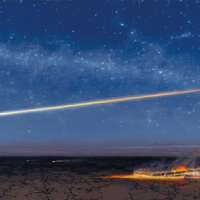28. TIM STORRIER

Tim Storriers outback paintings, complete with burning logs and dramatic skies, are among his most admired and sought after works from a long and successful career. At many points he has rung changes to the basic composition, introducing different celestial elements, the size and stage of the fire, and subtle variations in the proportion of each work. It is hard to explain why these works are so compelling, and why they continue to command high prices in a broad and diverse marketplace.
The first impression is always the impeccable technique of any painting. Storrier works for months to bring together the different elements, often on large canvases, as with this example, at three metres wide. There is no attempt, nor possibility of fudging the painting, no resorting to a big brush to fill in the vast skies and open spaces. When Storrier chooses to paint a thousand stars he will do just that, one at a time with painstaking detail.
As has been emphasised, Storrier does not wish to bring any deep philosophical or indeed political messages to his work and what you see is what you get in this case a beautifully conceived composition, executed with consummate skill and design. But there are messages and stories we gain by immersing oneself in Storriers personal rendering of an almost empty desert landscape. In its most basic form, it is about light in the creation of the work. While the statement applies to any landscape painting, this work has a deeply nuanced way of using light. There are half a dozen light sources illuminating the composition, each with its own story. The brightest light source, the burning logs, fills the lower right of the work. Their intense glow lights the surrounding clay pan, while sparks and embers lift into the evening sky.
There is no hint as to why they are there and why they burn into the night. This are no stockmen or animals around the warming fire. The sky is myriad with stars, each its own spot of intense light in the outer universe. They are random, but are fixed in time and space as beacons, and the markers for navigators over the centuries.
A jet aircraft lays a vapour trail across the sky. We wonder if it is a comet or a meteorite or some other natural phenomenon, but its trajectory, almost parallel to the horizon, tells us it is indeed an aircraft, heading to places unknown. Just below the horizon, a succession of glowing lights, pinpoint cars on a desert road, each lifting a cloud of dust. Each pair of lights is a driver, a tiny human presence, in a vast desert. Similarly, the mark of the speeding aircraft, is not meaningless, but a highly technical container for three hundred or more passengers.
One last subtle light source, a crescent moon, completes the composition. We contrast the natural light of stars, moon, and the unseen sun, with the mechanical moments of distant cars and aircraft. It is subtle theatre with many small moments for the viewer to imagine as they contemplate this grand and accomplished creation.
Gavin Fry
Gavin Fry is a writer, artist and museum professional with fifty years experience working in curatorial and management positions in Australian museums, galleries and educational institutions.